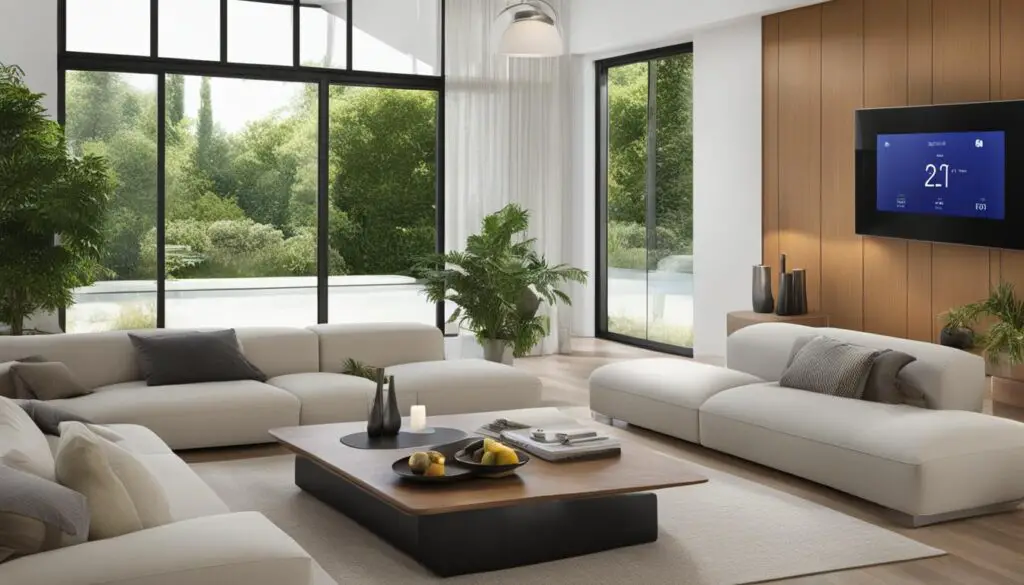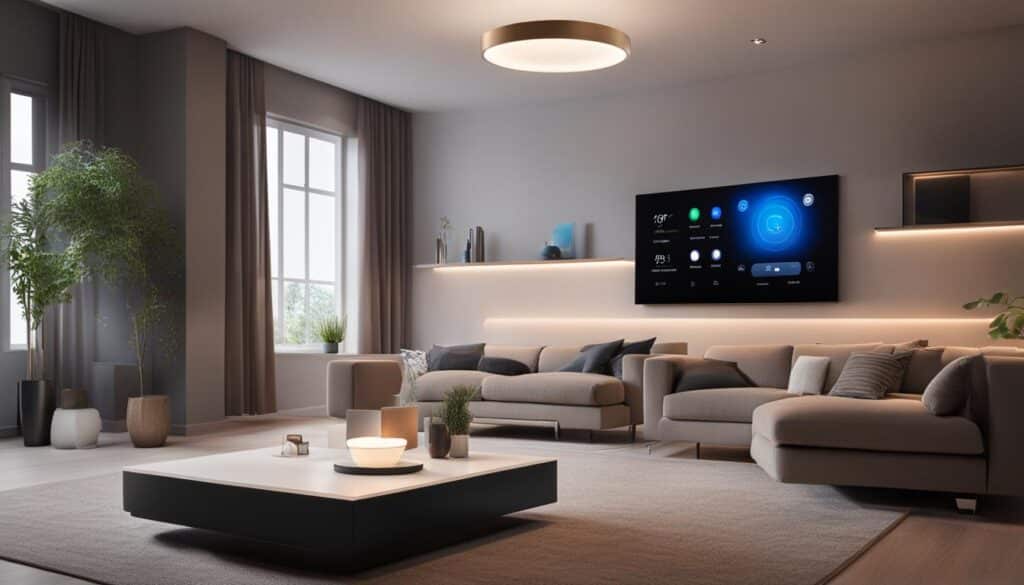Smart home technology has revolutionized the way we interact with our homes. With remote home automation via smartphone, homeowners can now control their home appliances, devices, and security systems from anywhere using a connected mobile device. This innovative technology offers a seamless and convenient way to manage and monitor your home, providing a range of benefits including enhanced security, energy efficiency, and simplified home maintenance.
Imagine being able to adjust your home’s temperature, turn off lights, lock doors, and even monitor security cameras while you’re away, all with a few taps on your smartphone. With smartphone-controlled home automation, this is now a reality. Whether you’re at work, on vacation, or simply lounging on the couch, you have complete control over your home at your fingertips.
This level of control offers peace of mind and convenience. You can receive security alerts, access camera footage, adjust lighting, and lock doors from anywhere, ensuring the safety of your home and loved ones. Additionally, smart home automation allows for energy efficiency by enabling the monitoring and control of energy-consuming devices like thermostats, lighting, and appliances. This not only helps reduce energy bills but also contributes to a more sustainable lifestyle.
The integration of smart devices into a remote home automation system further enhances the user experience. Homeowners can now manage all their connected devices through a single smartphone app or operating system, bringing convenience and simplicity to their everyday lives. From controlling smart plugs and thermostats to managing security systems and monitoring home maintenance, the possibilities are endless.
As technology continues to advance, the future of remote home automation holds even greater potential. More devices are becoming smart and connected, making it easier than ever to create a smart home ecosystem that is tailored to your needs and preferences. By embracing remote home automation via smartphone, you can unlock the full potential of your home, making it safer, more energy-efficient, and ultimately, more enjoyable to live in.
Table of Contents
Key Takeaways:
- Remote home automation via smartphone allows homeowners to control their home appliances and security systems using a connected mobile device.
- Smartphone-controlled home automation offers convenience, peace of mind, and enhanced security by providing remote access and control over various aspects of the home.
- Energy efficiency is achieved through the integration of smart devices, allowing homeowners to monitor and control energy-consuming devices like thermostats, lighting, and appliances.
- The integration of smart devices into a centralized system simplifies home management, offering a seamless and user-friendly experience.
- As technology advances, the future of remote home automation holds even greater potential for creating a smarter, more connected living environment.
Convenience and Safety of Remote Home Automation
Remote home automation via smartphone offers convenience and safety benefits to homeowners. With the ability to control devices from anywhere using a smartphone, homeowners can easily manage and monitor their home appliances and security systems.
Remote access to home security systems allows for receiving security alerts, accessing camera footage, locking doors, and adjusting lights. This provides peace of mind and increased control over home security, even when away from home.

Additionally, remote home automation can include features like water leak detection systems, which prevent water-related damage by notifying homeowners of changes in water pressure or shutting off water supply in case of significant leaks.
Overall, remote home automation offers a convenient and safe way to manage and protect your home using smartphone-controlled devices.
Smart Home Devices for Energy Efficiency
When it comes to remote home automation via smartphone, energy efficiency is a key consideration for homeowners. By integrating energy-efficient smart home devices into their automation systems, users can actively manage and reduce their energy usage, leading to lower energy bills and a more sustainable lifestyle.
One of the essential devices for energy efficiency is smart plugs. These devices allow homeowners to control lights and appliances remotely, giving them the power to monitor and reduce energy usage. With the ability to schedule on/off times and monitor energy consumption, smart plugs promote energy-efficient habits and help homeowners save on electricity bills.

Another device that plays a significant role in energy savings is the smart thermostat. These devices provide convenient control of home temperature settings and can learn the occupants’ preferences over time. By optimizing energy usage and reducing unnecessary heating and cooling, smart thermostats can save homeowners a significant amount of money on their energy bills.
For those looking to reduce energy consumption in their lighting systems, smart light bulbs are an excellent choice. These bulbs use less energy than traditional incandescent bulbs and can be controlled remotely through a smartphone app. Homeowners can customize lighting schedules, dim lights, and turn them off when not in use, resulting in reduced energy consumption and savings on electricity bills.
To highlight the benefits of these energy-efficient smart home devices, consider the following table:
| Smart Device | Features | Energy Efficiency |
|---|---|---|
| Smart Plugs | Remote control of lights and appliances | Monitors and reduces energy usage |
| Smart Thermostats | Convenient control of home temperature | Optimizes energy usage and reduces costs |
| Smart Light Bulbs | Remote control and customization of lighting | Uses less energy than traditional bulbs |
By incorporating these energy-efficient smart home devices into a remote home automation system, homeowners can take proactive steps towards a more sustainable and cost-effective lifestyle. With the power to monitor and control energy usage at their fingertips, users can make informed decisions that positively impact their energy bills and the environment.
Enhancing Home Security with Remote Home Automation
Remote home automation offers homeowners the ability to enhance their home security through smartphone-controlled devices. By utilizing smart home security systems, individuals can gain access to advanced features such as security alerts, remote viewing of security camera footage, door locking, and light adjustment.
With remote home automation via smartphone, homeowners can monitor their homes and receive instant notifications in the event of security breaches or suspicious activities. This level of connectivity and control provides peace of mind, as homeowners can stay connected to their homes even when they are away.
One of the key components of remote home automation for security is smartphone-controlled doorbells. These innovative doorbells, when integrated with the home automation system, provide homeowners with the ability to see and communicate with visitors even when they are not physically present. Offering real-time video and two-way audio communication, smartphone-controlled doorbells provide an added layer of security and convenience.
“With remote home automation via smartphone, homeowners can stay connected to their homes even when they are away.”
In addition to smartphone-controlled doorbells, smart locks play a vital role in enhancing home security. These intelligent locks offer users keyless entry and the ability to remotely control and monitor their doors using their smartphones. With smart locks, homeowners can easily lock and unlock their doors from anywhere, providing convenience and peace of mind.
Furthermore, remote access to security cameras is another crucial feature of remote home automation. Homeowners can remotely monitor their security cameras in real-time, ensuring constant surveillance and instant access to video feeds. This capability allows them to keep an eye on their property and respond quickly to any security threats or emergencies.
Benefits of Enhancing Home Security with Remote Home Automation:
- Real-time security alerts and notifications
- Remote access to security camera footage
- Convenient door locking and unlocking
- Increased visibility and communication with smartphone-controlled doorbells
- Enhanced control over home security from anywhere
By leveraging the power of remote home automation via smartphone, homeowners can significantly enhance their home security. With the ability to control security systems, communicate with visitors, and monitor security cameras remotely, individuals can enjoy peace of mind and a greater sense of control over their home.
Improved Home Maintenance with Remote Home Automation
Remote home automation via smartphone offers homeowners the convenience of easily managing and controlling various aspects of their homes, leading to improved home maintenance. With the ability to access and control devices from anywhere, homeowners can optimize their home maintenance routines and enhance the overall functionality and safety of their living spaces.
Water Leak Detection Systems
One of the significant advantages of remote home automation is the integration of water leak detection systems. These systems play a crucial role in preventing water-related damage by detecting changes in water pressure and promptly notifying homeowners of potential leaks. In the event of a significant leak, the system can automatically shut off the water supply, mitigating the risk of costly repairs and water damage.
Remote Access to Appliances
Remote access to appliances is another valuable feature of remote home automation. Homeowners can monitor and control their appliances, such as washers, dryers, and refrigerators, providing convenience and peace of mind. For instance, you can receive notifications when the laundry cycle is complete or adjust the temperature of your refrigerator while grocery shopping.
Smart Gardening Apps
Smart gardening apps and systems are a game-changer for homeowners who enjoy tending to their gardens. These apps automate plant watering based on real-time information on soil moisture levels. By providing optimal water amounts, smart gardening apps ensure the health and vitality of your plants, minimizing the risk of overwatering or underwatering. With remote access, you can monitor and adjust your garden’s irrigation system using your smartphone, even when you’re away from home.
Smart Smoke Alarms and Carbon Monoxide Detectors
Remote home automation also offers enhanced safety features through smart smoke alarms and carbon monoxide detectors. These devices provide safety alerts and notify homeowners of potential fire or gas hazards, even when they are not at home. By receiving timely notifications on their smartphones, homeowners can promptly respond to emergency situations and protect their homes and loved ones.
Monitoring Home Electrical System
A key aspect of home maintenance is monitoring the electrical system for potential dangers. Remote home automation enables homeowners to remotely monitor their home’s electrical system, identifying abnormal electrical behavior or potential hazards in real-time. Early detection of electrical issues allows homeowners to take proactive measures and prevent potential accidents or damages.
In conclusion, remote home automation via smartphone greatly simplifies home maintenance and offers convenient control over various aspects of the home. From detecting and preventing water leaks to remote access of appliances, smart gardening apps, and enhanced safety measures with smart smoke alarms and carbon monoxide detectors, homeowners can ensure a safe and well-maintained living environment. Additionally, remote monitoring of the electrical system allows for early detection of potential hazards, minimizing the risk of accidents. By embracing remote home automation, homeowners can enjoy the benefits of a smarter, safer, and more efficient living space.
Integration of Smart Devices with Remote Home Automation
The integration of smart devices is a crucial element in achieving seamless remote home automation. With the help of a single control app for smart home devices, homeowners can effortlessly manage all their connected devices through a centralized interface on their smartphones. This convenience revolutionizes the way we interact with and manage our homes.
Popular smart home apps like Home Assistant, Apple Home, Amazon Alexa, and Google Home turn smartphones into control centers, giving users the ability to monitor and control their entire smart home automation system. Whether it’s adjusting the thermostat, turning off lights, or checking security cameras, all these tasks can be easily accomplished with just a few taps on the smartphone screen.
Moreover, platforms such as the Control4 Smart Home Operating System provide homeowners with a comprehensive solution for integrating and controlling all their smart devices. With Control4, users can enjoy a seamless and unified experience, ensuring all their smart devices work together flawlessly.
By leveraging a smart home app or operating system, homeowners can receive important notifications and alerts when specific aspects of their home automation system require attention. Whether it’s a water leak detection system signaling potential damage or a smoke alarm warning of a potential fire hazard, remote access via smartphone ensures that homeowners are always in the know and can take prompt action.
Integration of smart devices enables homeowners to conveniently manage their entire remote home automation system with ease. The ability to control and monitor various aspects of the home from a centralized platform empowers homeowners to create a personalized and connected living environment.
Ready to transform your home into a smart and connected oasis? Discover the power of integration and take full control of your home automation system with the convenience and ease of remote access via smartphone.
Examples of Remote Home Automation Devices
Remote home automation via smartphone offers a wide range of smart devices that can be controlled through a smartphone. These devices provide convenience, efficiency, and enhanced functionality in managing various aspects of your home. Whether it’s controlling your appliances, monitoring your home security, or optimizing energy usage, there are numerous options available to suit your needs. Here are some examples of smart home devices that can be controlled remotely via smartphone:
- Smartphone-Controlled Oven: Easily manage temperature, cooking time, and preset cooking programs using your smartphone, ensuring perfectly cooked meals even when you’re away.
- Garage Door Opener: Open and close your garage door remotely, ensuring secure access to your home from anywhere.
- Washer and Dryer: Start, stop, and monitor your laundry cycles using your smartphone, allowing you to conveniently manage your laundry even when you’re not at home.
- Refrigerator: Receive notifications for temperature changes, track food inventory, and control temperature settings remotely, ensuring optimal freshness and energy efficiency.
- Hot Tub Control: Adjust water temperature, activate jets and lights, and set timers for your hot tub, creating a relaxing spa experience from your smartphone.
- Sprinkler System: Control watering schedules and adjust water flow for your garden or lawn, ensuring optimal plant health and conservation of water resources.
- Baby Monitor: Monitor your baby’s activity, view live video feeds, and receive alerts for sound or motion detection, providing peace of mind while you’re away.
- Speakers: Stream music wirelessly to your speakers from your smartphone, creating a personalized and immersive audio experience throughout your home.
- Pet Feeder: Feed your pets on a schedule or with manual control, ensuring they are well taken care of even when you’re not at home.
- Air Conditioner: Adjust temperature settings, fan speed, and energy-saving modes remotely, ensuring comfort and energy efficiency.
- Instant Pot: Manage cooking programs, set timers, and monitor progress from your smartphone, simplifying meal preparation and saving time in the kitchen.
- Doorbell: Receive notifications, view live video feeds, and communicate with visitors at your front door, enhancing home security and convenience.
- Thermostat: Adjust temperature settings, set schedules, and monitor energy usage remotely, optimizing comfort and reducing energy costs.
- Light Switch: Control lights individually or in groups, set timers, and create customized lighting scenes to suit different moods and occasions.
- Pet Camera: Watch live video feeds, engage in two-way communication, and dispense treats to your pets, bringing peace of mind and interaction even when you’re away.
- Sous Vide Cooker: Control cooking temperature and time remotely, ensuring precision cooking for restaurant-quality results.
- Plugs: Control power supply to your devices and appliances individually or in groups, providing convenience and energy-saving opportunities.
- Sonte Film: Control the opacity of smart window film to adjust privacy levels and regulate natural light entering your home, creating a comfortable and customizable living environment.
These are just a few examples of the many smart home devices available that can be remotely controlled via smartphone. The possibilities are vast, allowing you to transform your home into a more convenient, secure, and efficient living space.
Conclusion
Remote home automation via smartphone offers a multitude of benefits that enhance our daily lives. With the convenience of smartphone-controlled home automation, homeowners can effortlessly control and monitor various aspects of their homes from wherever they are. This level of control provides a more convenient and secure living environment, offering peace of mind and ease of use.
One of the key advantages of remote home automation is the enhanced home security it provides. Through remote access, homeowners can easily manage security systems, receive alerts, and even control devices like doorbells and locks. This not only increases home security but also allows homeowners to keep an eye on their property, even when they’re away.
In addition to security, remote home automation promotes energy efficiency by enabling homeowners to control and monitor smart devices such as thermostats, light bulbs, and appliances. By optimizing energy usage and reducing waste, homeowners can contribute to a more sustainable lifestyle and lower their energy bills.
The integration of smart devices through a centralized app or operating system further simplifies home maintenance tasks. With remote home automation, homeowners can easily manage water leak detection systems, monitor home appliances, automate gardening systems, and receive safety alerts from smoke alarms and carbon monoxide detectors. This seamless integration not only saves time but also ensures a well-maintained and safe home.
Looking forward, the future of remote home automation is promising. As technology continues to advance, we can expect more smart devices to be integrated into home automation systems, offering homeowners unparalleled control and automation capabilities. This evolution will further enhance the convenience, security, and energy efficiency of remote home automation, empowering homeowners to unlock the full potential of their homes and enjoy a more comfortable and connected living experience.
FAQ
How does remote home automation via smartphone work?
Remote home automation via smartphone allows homeowners to control their smart home devices, appliances, and security systems using a smartphone or tablet through an internet connection. Using a smartphone app or a centralized control system, homeowners can remotely monitor, manage, and adjust various aspects of their home, such as security settings, thermostats, lighting, and even appliances.
What are the benefits of remote home automation?
Remote home automation offers several benefits, including convenience and ease of use. With remote access to home automation devices via smartphone, homeowners can conveniently control various aspects of their homes from anywhere at any time. Additionally, remote home automation enhances home security, saves energy through the use of smart devices, simplifies home maintenance tasks, and allows for the integration of multiple smart devices through a single app or operating system.
How does remote home automation enhance home security?
Remote home automation enhances home security by providing homeowners with the ability to monitor and control their security systems remotely. This includes features such as receiving security alerts, accessing camera footage, locking doors, adjusting lights, and controlling smart locks. With remote access to security cameras and video doorbells, homeowners can keep an eye on their property and communicate with visitors, even when they are not at home.
Can remote home automation save energy?
Yes, remote home automation can save energy through the use of energy-efficient smart devices. Smart plugs allow homeowners to control lights and appliances, helping to monitor and reduce energy usage. Smart thermostats provide convenient control of home temperature settings, optimizing energy usage and reducing costs. Smart light bulbs use less energy than traditional bulbs and can be controlled remotely, allowing users to customize lighting schedules and reduce unnecessary energy consumption.
How does remote home automation simplify home maintenance?
Remote home automation simplifies home maintenance by providing easy access and control over various aspects of the home. For example, water leak detection systems can alert homeowners to potential water-related damage by detecting changes in water pressure and shutting off the water supply if a significant leak is detected. Remote access to appliances allows for monitoring and control of devices such as washers, dryers, and refrigerators, providing convenience and peace of mind.
Can smart devices be integrated into a remote home automation system?
Yes, smart devices can be integrated into a remote home automation system. A single smart home app or operating system allows homeowners to control and manage all connected devices through a centralized interface on their smartphones. This seamless integration of smart devices enhances the convenience and ease of managing a remote home automation system.
What are some examples of remote home automation devices?
Some examples of remote home automation devices include smart ovens, garage door openers, washers and dryers, refrigerators, hot tub controls, sprinkler systems, baby monitors, speakers, pet feeders, air conditioners, instant pots, doorbells, thermostats, light switches, pet cameras, sous vide cookers, plugs, and Sonte film, among many others.
What are the benefits of remote home automation via smartphone?
Remote home automation via smartphone offers numerous benefits, including convenience, enhanced home security, energy efficiency, simplified home maintenance, and the integration of smart devices. With the ability to control and monitor various aspects of the home from a smartphone, homeowners can enjoy a more convenient and secure living environment while also reducing energy consumption and simplifying home maintenance tasks. The integration of smart devices and centralized control further enhances the user experience and makes managing a remote home automation system seamless and efficient.


